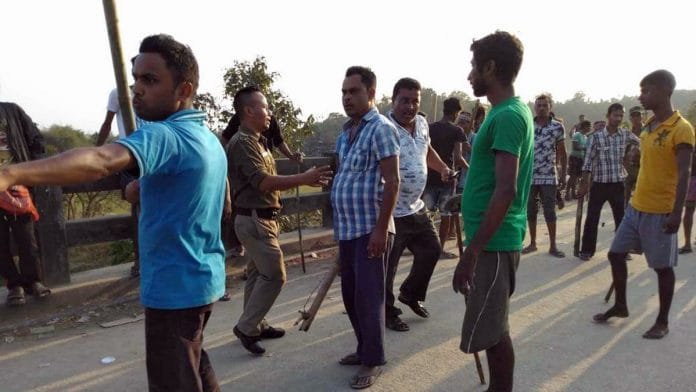New Delhi: Meghalaya is a tiny state, with approximately 30 lakh people stretched across 22,000 square kilometers. On the south side it borders Bangladesh and on the northern side it borders Assam. But over the last few days, Meghalaya has been in the throes of the same CAA-NRC tensions which are occuring in other parts of the country, though for different reasons.
Meghalaya came into being in 1972 after Assam was reorganised, and has a population of over 90 per cent tribals. They are divided into two broad groups — the Garos (in the western side of the state), and the Khasis (in the east).
Khasis are about 56 per cent and Garos are about 34 per cent. Garo politicians have tended to rule Meghalaya because they have not been divided into several parties, as the Khasis have.
Meghalaya hasn’t had a real insurgency. A short lived insurgent group by a Khasi clan, called the Hynniewtrep National Liberation Council (HNLC) had come up and grew to include some Garos as well before surrendering in 2007.
Also read: Violence over CAA kills 3 in Meghalaya, curfew & mobile internet restrictions imposed
Meghalaya has, however, had a prolonged insecurity over “outsiders”. Here are the tensions in Meghalaya explained in five points:
What exactly happened?
On Friday, the Khasi Students Union was holding an anti-CAA protest in the southern side of Meghalaya, in Ichamati, which borders Bangladesh. This is where several Bengali speaking peoples — both Hindu and Muslim — have settled and formed colonies.
Local papers say members of the KSU and non-tribals clashed after a haystack was put on fire, and it escalated leading to one person being killed.
What are people and tribals of Meghalaya protesting against?
The tribals of Meghalaya are against the CAA and NRC because they don’t want “outsiders” coming in to take their land and businesses or dominating their economy. These fears have persisted since, compared to its neighbours, Meghalaya has been the most open state.
Meghalaya is also the only state with a large city of cosmopolitan retentions, that being Shillong. The people of Meghalaya worry that because of the fear of CAA in Assam, Bengalis will come rushing into Shillong and settle down there. They also fear that Hindus from Bangladesh will come into India through Meghalaya with the hope of acquiring citizenship. In other words, they feel vulnerable on both sides.
If they are already protected from the CAA what are they complaining about?
A small area in Shillong city is the only place where CAA would apply in the state, as most of Meghalaya is exempted from CAA because it enjoys provisions under the Sixth Schedule.
The students, therefore, are not protesting against just the CAA, but they don’t want anyone affected by the CAA — those at risk of being identified as foreigners — coming into Shillong.
How Meghalaya’s protests are the opposite of anti-CAA protests elsewhere
In places like Delhi, anti-CAA protests are about discrimination bolstered by Muslim insecurity. These protests are more liberal, claiming that one community cannot be excluded. But in the North-East, the protests are more secular, demanding that all communities, regardless of religion, be left out.
In the North East, they seek to protect their linguistic, cultural, ethnic, and tribal identity. They fear that an influx of outsiders can upset that balance, since they are already a small minority.
What is the Inner Line Permit?
While protesting the CAA, the people of Meghalaya are also demanding the implementation of something called the Inner Line Permit, which was a system started by the British.
In the 19th century, the British drew something of an imaginary line which decreed that people who lived outside of the boundary could not enter without a permit. They did this to protect their business interests, since they had discovered oil and started growing tea in Assam.
Later, those restrictions were provided to delicate tribal states like Mizoram, Nagaland, and Arunachal Pradesh, but Meghalaya never had it. In the wake of the anti-CAA protests, which reintroduced the fear of outsiders, Meghalaya’s Assembly unanimously passed a resolution urging the Government of India to implement Inner Line Permit in the state.
If this happens, it will be a regressive step for the North East, considering over the years, the requirements of the ILP have softened and been diluted.
Also read: What data and history of India and its capital tell us about Delhi’s riots







Khasi domination has gone,why don’t khasi just understand.they cannot put back laws of jungle.meghalaya itself is part of khasi,Garos and jaintia hills.meghalaya itself is part of Indian union,don’t think you can seccceed.also,khasi are not indigenous of bangladesh.they came during the kingdom of jaintia,whereas Bengalis existed before 1st millennium bce.banglapedia-aryanisation of Bengal.so foreigners cannot make decision on Bangladesh,not an inch of sylhet will be given to them.srihatta was an independent kingdom and shall remain,wiki-gaur dynasty.